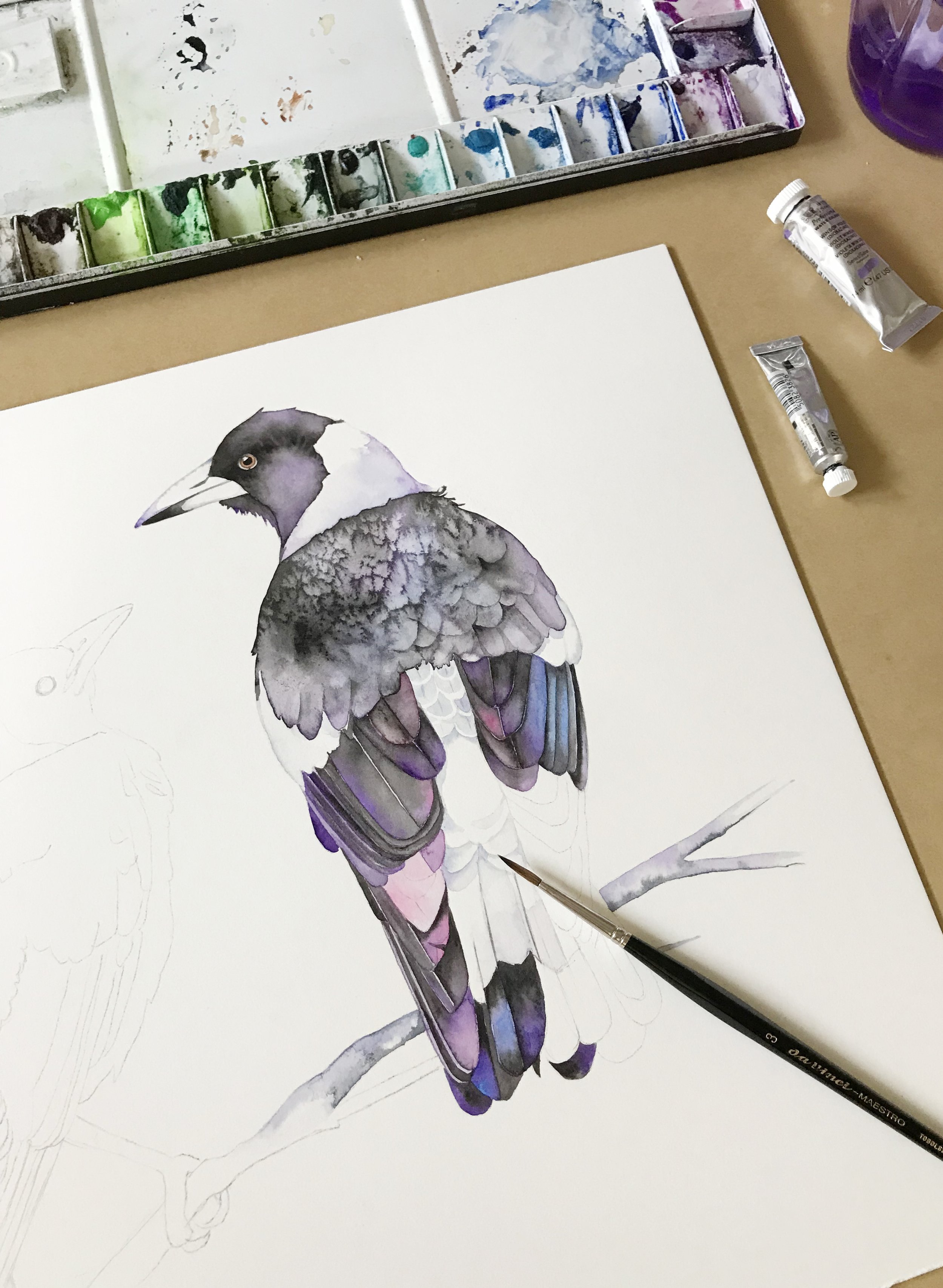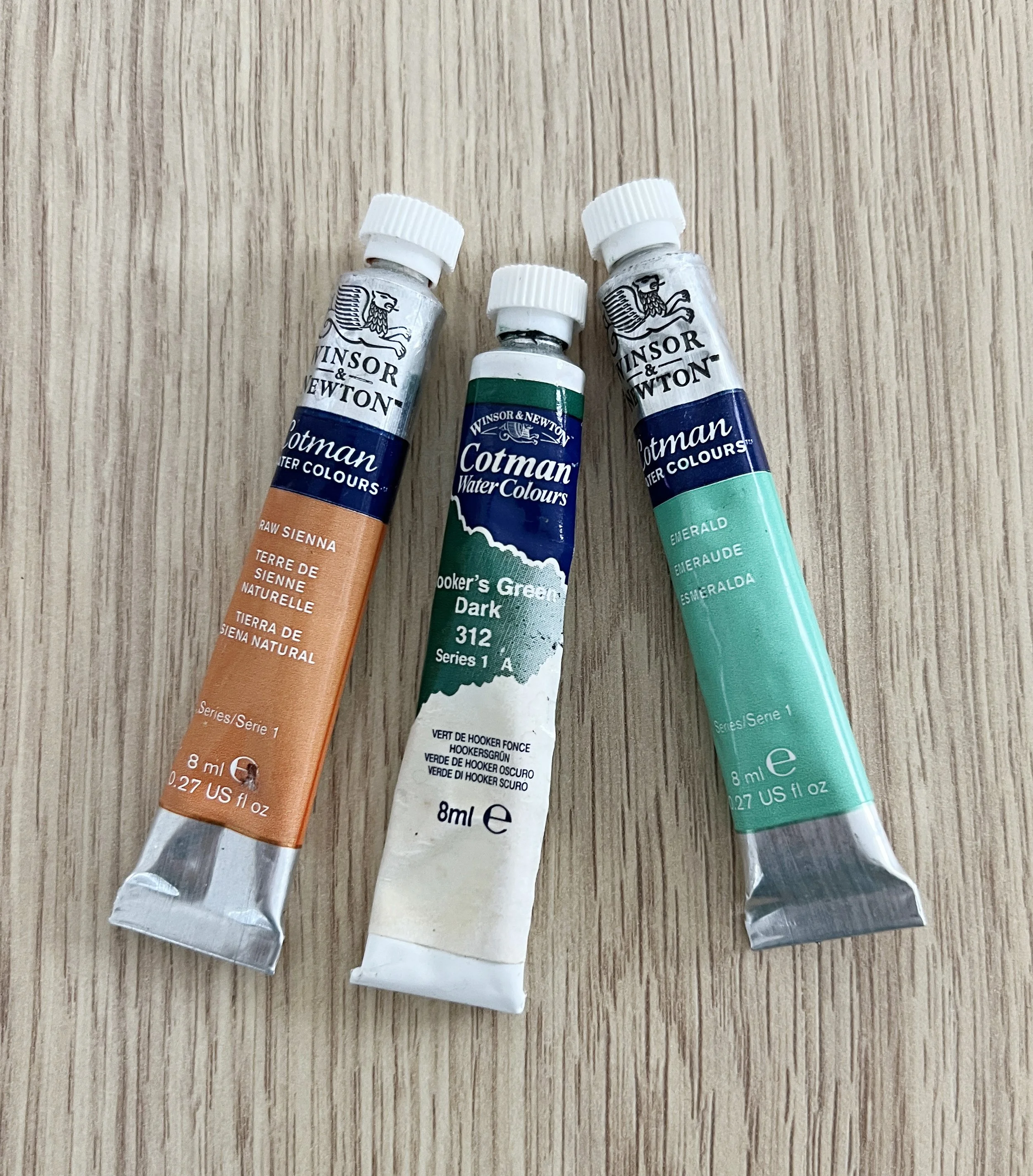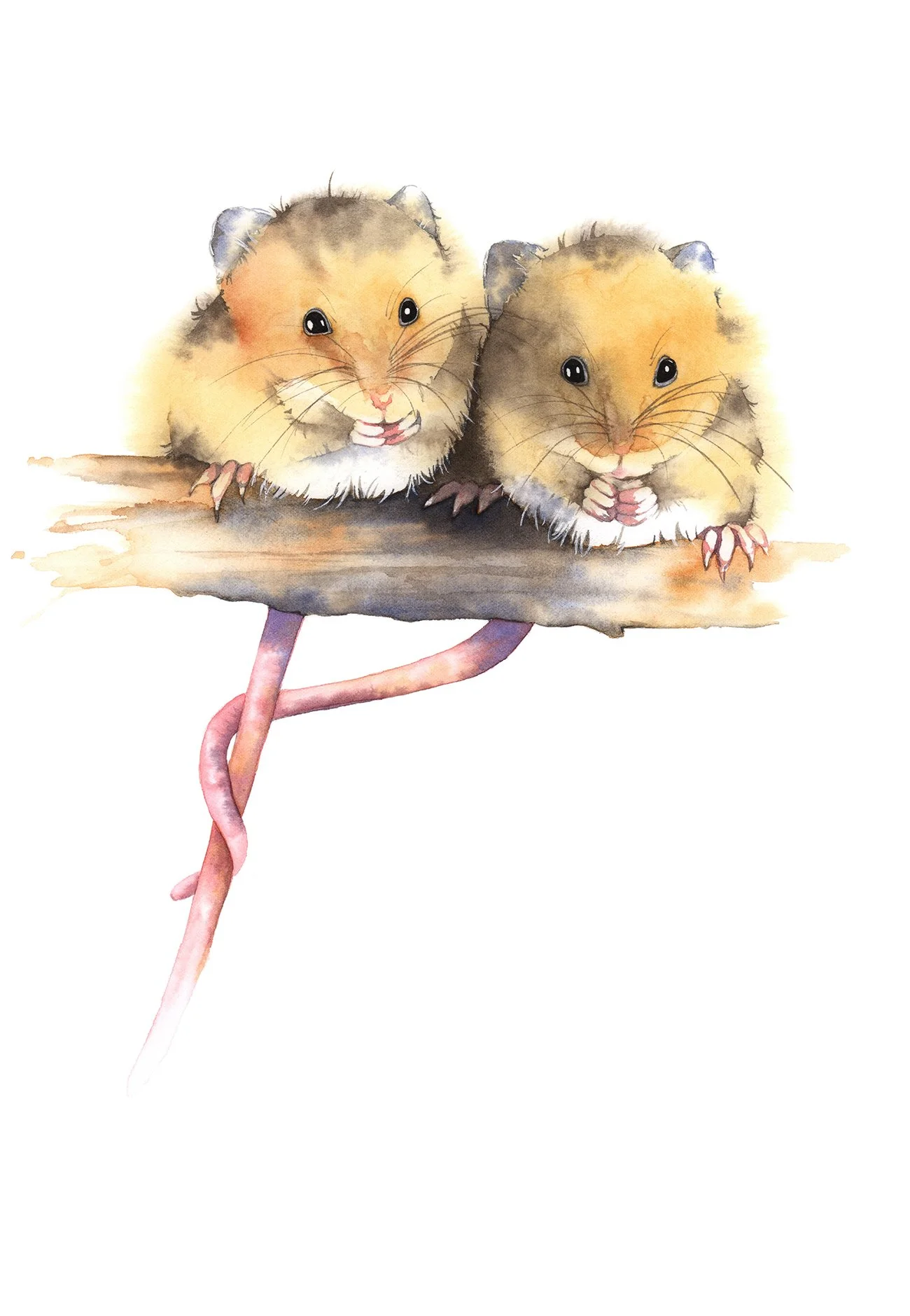Ultimate Watercolour Glossary: Key Terms Every Artist Should Know
A watercolour painting of some Ranunculus flowers in progress.
Dive into the splashy, unpredictable world of watercolour with a word list that's more colourful than my palette after a day's work. Think of this not just as a list, but as your trusty sidekick in the art studio, ready to decode the mysterious language of watercolours. From the gravity-defying "wet on wet" technique to the rebellious "back runs" that refuse to stay put, these terms are the secret handshake of the watercolour society. So, grab your brush (or just your curiosity), and let's unravel the mysteries of watercolour together. Who knows? By the end, you might just find yourself speaking "artist" fluently, impressing your friends and your paints alike.
Watercolour Terms from A-Z:
A Hummingbird painted on Arches watercolour paper.
Absorbency: The paper's ability to absorb water and paint, influencing how watercolours behave on its surface.
Acid-Free: Paper free from acidic substances that can cause deterioration or yellowing over time.
Arches Paper: A high-quality watercolour paper known among painters for its superior performance and longevity.
Artist's Grade: High-quality materials with more pigment and less filler for better colour intensity and permanence.
Back Run: An effect caused by adding more water to a damp wash, resulting in textured patterns, also known as "cauliflower", "bloom" or "blossom."
Blotting: Removing excess water or paint with a paper towel or sponge to lighten an area or create texture.
Blooms: Irregular patterns created when wet paint spreads into a drier area.
In this watercolor painting you can see some examples of blooms forming.
Body Colour: refers to opaque pigments used in painting, as opposed to transparent ones, allowing for solid coverage without showing the underlying surface or layers.
Brushwork: The application technique and personal skill in using brushes, encompassing various strokes and effects.
Charging: Introducing one colour into another without fully mixing, allowing them to blend on the paper.
Cold Press: Watercolour paper with a slightly textured surface, offering artists a medium between rough and hot press.
Colour Lifting: Removing or lightening the colour from a painting, often by using a damp brush or sponge.
Deckled Edge: The feathery edges of some watercolour paper sheets, a characteristic of handmade paper.
The deckled edge of a sheet of Arches watercolour paper.
Deckled Edge Tool: A tool or technique used to create a deckle edge on watercolour paper that doesn't naturally have one.
Dry Brushing: A technique using a brush with very little water and paint to create a rough, textured effect.
Dry on Dry: Applying dry paint to dry paper for sharp, defined edges.
Edge Control: Managing the hardness or softness of edges in a painting to define forms and suggest depth.
Opera Rose: A vibrant but fugitive pigment.
Fugitive Pigment: A pigment prone to fading over time when exposed to light.
Gatorbord: a durable, lightweight, and water-resistant foam board, favoured by artists for securely mounting stretched watercolour paper, thanks to its rigid exterior.
Glazing: Layering thin, transparent washes of colour, allowing the underneath layers to show through.
Gouache: An opaque watercolour paint made with added white pigment for opacity.
Granulation: The textured effect created when pigments settle into the paper's valleys, producing a mottled appearance.
I used Schmincke's French Ultramarine on this Black Cockatoo painting (a granulating pigment) and you can see the granulation ocurring.
Graded Wash: A wash that gradually changes in tone or colour across the paper.
Gum Arabic: The water-soluble resin extracted from acacia trees, used as a binding agent in watercolour paints to control the spread of the pigment and enhance colour brightness.
Gummed Tape: an adhesive tape with a water-activated glue layer, commonly used in art for stretching watercolour paper to prevent it from buckling when wet.
Hard Edges: Sharp, clear edges in a painting, created by painting on dry paper or allowing paint to dry completely before adding another layer.
Hot Press: Smooth, pressed watercolour paper offering fine detail with less texture than cold press.
Hue: The colour or shade of paint.
Japanese Watercolour: Watercolour style or materials from Japan, known for their distinct pigments and brushes.
Layering: Applying multiple layers of paint, allowing each to dry before the next, to build depth and complexity.
Lifting: Removing paint from an area of the painting, usually with a damp brush or cloth, to lighten it or correct mistakes.
Lightfastness: The resistance of a pigment to fading when exposed to light.
Masking: Using masking fluid to protect areas of the paper from receiving paint, keeping them white or at a previous colour stage.
A Da Vinci Casaneo mop brush.
Mop Brush: A large, round, absorbent brush used for broad washes.
Negative Painting: Painting around an object to define its shape, emphasising the space around and behind the subject.
Opaque Watercolour: Paint that is not transparent; it cannot be seen through and covers layers beneath it.
Ox Gall: a natural wetting agent derived from bile, added to watercolour paints to improve their flow and spread on the paper by reducing surface tension.
Palette: A surface on which paints are mixed.
Watercolor paint in 2 seperate palettes.
Watercolour paint pans in a tin.
Paper Weight: The weight of the paper, indicating its thickness and durability, typically measured in pounds (lb) or grams per square metre (gsm).
Pan Paints: Small, compact cakes of paint that are activated with water.
Pigment: Finely ground, coloured pigment particles that provide paint its colour and opacity.
Plein Air: Painting outdoors, directly from life, capturing natural light, landscape and atmosphere.
Rigger Brush: A long, thin brush used for painting fine lines.
Ruling Pen: a precision drawing tool with adjustable blades, used by artists and draftsmen to create fine lines and varied line widths with ink or other fluid media such as masking fluid.
The texture on the back of the Australian Magpie was created by sprinkling salt onto the wet paint.
Salt Technique: Sprinkling salt on wet paint to create textured, starburst patterns as it dries.
Sable Brushes: Brushes made from sable hair, valued for their fine point and excellent water holding capacity.
Scumbling: Applying a light, broken layer of paint to create texture or depth, often with a dry brush.
Sizing: A substance applied to paper to decrease absorbency, allowing smoother washes.
Soft Edges: Fuzzy or not clearly defined edges, created by painting on wet paper or by blending the edges of wet paint.
Splattering: A technique where paint is flicked onto the paper with a brush, creating a speckled effect.
Squirrel Brushes: Made from squirrel hair, these brushes are known for their softness and high water-holding capacity, ideal for large washes.
Staining paints: Paints that soak into the paper and are difficult to lift off once dry.
Stretching paper: The process of preparing watercolour paper by wetting and then drying it stretched to prevent warping and buckling when wet paint is applied.
Winsor & Newton 'Cotman' watercolour paints are student grade.
Student Grade: More affordable materials. The student grade paints generally have less pigment and more fillers, suitable for beginners or practice work.
Synthetic Brushes: Brushes made from man-made fibres, offering an affordable and durable alternative to natural hair brushes.
Tide Lines: Edges formed by paint drying at different speeds, often creating rings or lines that can add texture or depth.
Tonal Value: The lightness or darkness of a colour, important for creating contrast and visual depth in a painting.
Transparent Watercolour: Paint that allows light to pass through it, showing the layers beneath and creating a sense of depth.
Tubes: Watercolour paint packaged in tubes, offering a creamier consistency than pans and allowing for a more fluid mixing of paints.
Underpainting: The initial layer of paint applied to a surface, which serves as a base for subsequent layers, often used to establish tones and values.
A Fairy Wren painting with a variegated wash in the background.
Variegated Wash: A variegated wash is an example of a watercolour technique where multiple colours blend smoothly on the paper, creating a gradient effect.
Wash: a painting technique involving a broad application of diluted paint, creating a uniform or gradually changing area of colour across the paper.
Watercolour Block: A pad of watercolour paper that is glued on all four sides to prevent warping; each sheet can be removed after drying.
Watercolour Mediums: Additives that can be mixed with watercolours to alter their properties, such as increasing transparency, gloss, or texture, enhancing the versatility of watercolour paints.
Watercolour Bead: The puddle of paint that forms at the edge of a wash, allowing for even spreading when the paper is tilted.
Wet on Dry: Applying wet paint onto dry paper for sharp edges and controlled shapes, allowing for detailed work and layering.
Wet on Wet: Applying wet paint to wet paper for soft, diffuse edges and blending colours seamlessly, ideal for backgrounds and soft transitions. This is one the fundamental watercolour techniques to learn.
Final Comments
And there you have it, a colourful expedition through the world of watercolour painting terms! But the journey doesn’t end here. If there are any other mysterious watercolour words you're wrestling with, or if you have a favourite term that I missed, drop a comment below. I'd love to hear from you and expand our collective watercolour lexicon together. Your insights and inquiries are the splashes of inspiration that keep this artistic community vibrant and evolving.
So, don't be shy—let's continue the conversation and paint the comments section with your thoughts and questions!
See our full page of Glossary terms.
If you are interested in learning to paint in watercolour, I have over 200 online, voiced over watercolour tutorials for all skill levels.

















